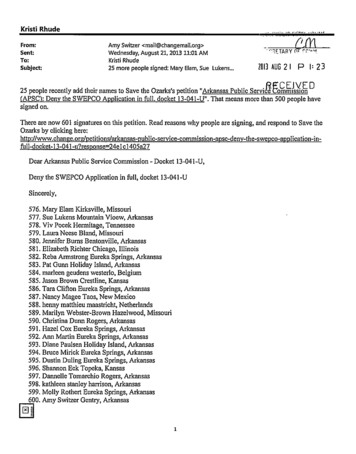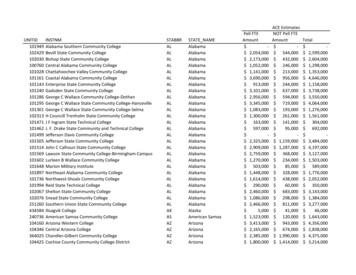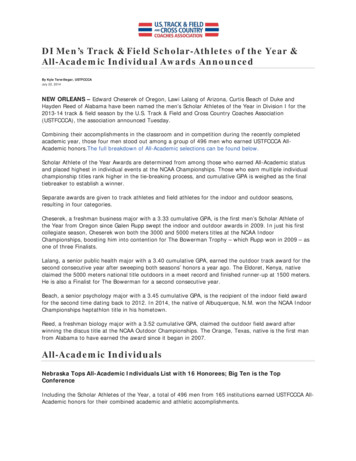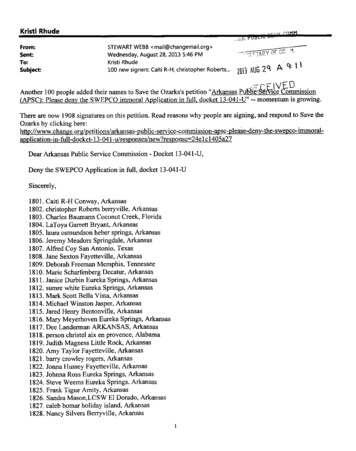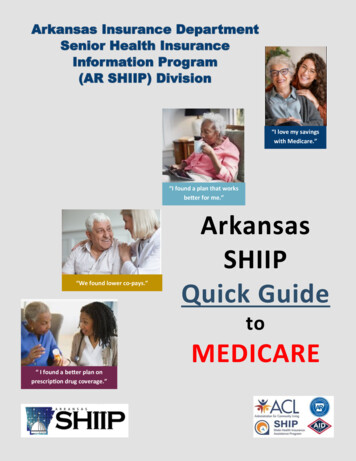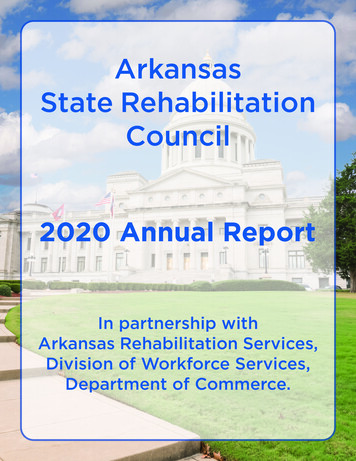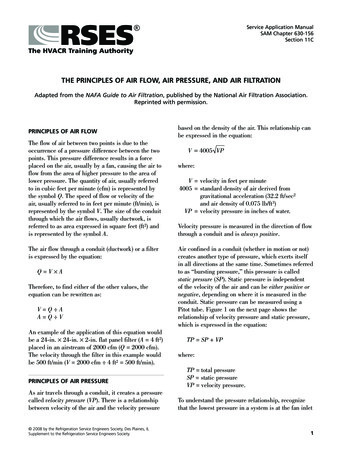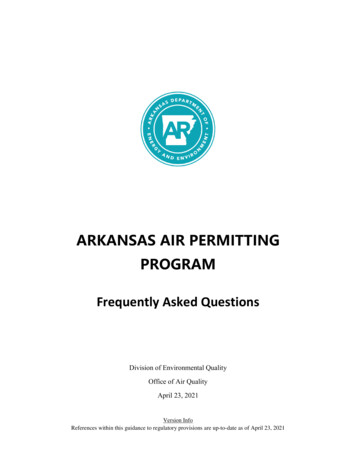
Transcription
ARKANSAS AIR PERMITTINGPROGRAMFrequently Asked QuestionsDivision of Environmental QualityOffice of Air QualityApril 23, 2021Version InfoReferences within this guidance to regulatory provisions are up-to-date as of April 23, 2021
About this GuidanceThis permitting guidance document is intended to highlight some of the most common questionsthat an owner or operator of a facility has when applying for an air permit in Arkansas.Permitting provisions found in Arkansas Pollution Control and Ecology Commission (APC&EC)Rules 18, 19, 26, and 31 as well as federal regulations referenced within the Rules are thefoundation for this document, and should always be consulted for specific projects. 1 You mayalso contact the Division of Environmental Quality (DEQ) Office of Air Quality (OAQ) s/forms/questions-intro.aspxIf inconsistencies exist between this guidance document and the currently effectiveAPC&EC Rules or State Code, APC&EC Rules and Arkansas statutes take precedenceover this guidance document. Currently, the current APC&EC Rules may be found at:http://www.adeq.state.ar.us/regs/. State statutes may be found at:https://advance.lexis.com/container?config ZTQKAFBvZENhdGFsb2cubRW4ifTiwi5vLw6cI1uX&crid 6973fa82e75d-43d7-966f-24fce0fda207&prid ce134e2b-2590-40be-8441-fc32d6cef537.For additional resources related to the Arkansas Air Permitting Program, visit the DEQ OAQPermits Branch webpage at: https://www.adeq.state.ar.us/air/permits/.This document does not constitute legal advice.1APC&EC is in the process of transitioning from the term “regulation” to “rule” in compliance with Act 315 passedin the Arkansas 2019 legislative session. Therefore, some “rules” referred to in this document may continue to betitled as a “regulation” until amended by APC&EC to make the transition in terms.
List of Acronyms and AbbreviationsDEQArkansas Department of Energy and Environment, Division ofEnvironmental QualityADHArkansas Department of HealthAPC&ECArkansas Pollution Control and Ecology CommissionAQCRAir quality control regionsAQRVAir Quality Related ValueArk. Code Ann.Arkansas Code AnnotatedBACTBest Available Control TechnologyBEIBiological Exposure IndicesBSERBest System of Emission ReductionCAAClean Air ActCAIRClean Air Interstate RuleCAOConsent Administrative OrderCASChemical Abstracts ServiceCEMContinuous Emissions MonitoringCFRCode of Federal RegulationsCH4MethaneCOCarbon monoxideCO2Carbon dioxideCO2eCarbon dioxide equivalentVersion 1 – April 2021a
CONGas-phase condensable particulate matterCSAPRCross-State Air Pollution RuleEGEmissions guidelinesEGBEEthylene glycol monobutyl etherEPAU.S. Environmental Protection AgencyFILFilterable particulate matterFLMFederal Land ManagerGC-5General condition fiveGHGGreenhouse gasesHAPHazardous air orocarbonsHRIHeat rate improvementLAERLowest Achievable Emissions RateN2ONitrous oxideNAAQSNational Ambient Air Quality StandardsNESHAPNational Emissions Standards for Hazardous Air PollutantsNO2Nitrogen dioxideNOINotice of IntentNOVNotice of ViolationNOxNitrogen oxidesVersion 1 – April 2021b
NSPSNew Source Performance StandardsOAQArkansas Department of Energy and Environment, Division ofEnvironmental Quality, Office of Air QualityODSOzone-depleting substancesPAERPresumptively Acceptable Emission RatePAILPresumptively Acceptable Impact LevelPALPlantwide Applicability LimitationsPFCsPerfluorocarbonsPMParticulate matterPM2.5Fine particulate matterPM10Coarse particulate matterPOMPolycyclic organic matterppbParts per billionPRIPrimary particle pollution (includes FIL and CON components)PSDPrevention of Significant DeteriorationRACTReasonably Available Control TechnologyRMPRisk Management PlanROResponsible officialSAEDSurfactant alcohol ethoxylates and their derivativesSDSSafety Data SheetsSF6Sulfur hexafluorideVersion 1 – April 2021c
SILSignificant Impact LevelSIPState Implementation PlanSO2Sulfur dioxideTLVThreshold limit valuetpyTons per yearVOCVolatile organic compoundsVersion 1 – April 2021d
Table of ContentsI.AR Permit System Overview . 1A. Permitting Under the Arkansas Water and Air Pollution Control Act . 1B. Arkansas Federally Approved and Delegated Programs . 1C. Arkansas Pollution Control and Ecology Commission (APC&EC) Rules . 21.Rule 18: Arkansas Air Pollution Control Code. 32.Rule 19: Rules of the Arkansas Plan of Implementation for Air Pollution Control . 33.Rule 26: Rules of the Arkansas Air Operating Permit Program . 44.Rules 8 and 9, and the Arkansas Code . 4D. One vs. Two Permit System. 41. Pre-Construction Permits vs. Operating Permits: What are the different processes andhow do they work if only one permit is issued? . 42. Which parts of a permit are Title V-derived requirements and which parts areconstruction-permit-based? . 5E. State Implementation Plan (SIP) . 51.What is a SIP? . 52.Is Rule 19 the Arkansas SIP? . 53.Who enforces the SIP? . 64.What is SIP Gap? . 6F.Relation to Federal Rules . 61.Delegated, Approved, Implemented as an “Applicable Requirement” . 62.Part 70 (Title V Operating Permit Program) . 63.Prevention of Significant Deterioration (PSD) . 74. New Source Performance Standards (NSPS) and National Emissions Standards forHazardous Air Pollutants (NESHAP). 8II.5.Programs not delegated to DEQ . 106.Acid Rain Trading Program . 117.The Cross-State Air Pollution Rule (CSAPR) . 128.Asbestos . 139.Lead . 13Arkansas-Administered Programs . 14Version 1 – April 2021i
A. What type of air pollution is regulated? . 14B. What is a Volatile Organic Compound (VOC), and is there a list of VOC? . 15C. What is a Hazardous Air Pollutant (HAP)? . 171.How do I determine if a compound is categorized as a HAP? . 172.How does the 10 tpy threshold apply to an aggregate group of HAP? . 173.How does the 10 tpy threshold apply to Polycyclic Organic Matter (POM)? . 174.What about glycol ethers? . 19D. What standards may DEQ use to evaluate HAP? . 19E. How are Greenhouse Gases (GHG) regulated? . 201.Clean Air Act (CAA) § 111 . 202. State and federal plans pursuant to Emissions Guidelines for Existing Sources under §111(d) of the CAA . 203.F.GHG under the PSD Program . 20How is Particulate Matter Regulated? . 211.PM2.5 and PM10 NAAQS . 212.Types of Particulate Matter . 213.What types of PM should be reported to the Emissions Inventory? . 224.What types of PM are referenced for permitting purposes?. 22G. What if I have a question about OAQ’s application of a particular regulatory requirement?22H. Dispersion Modeling . 231.Statutory framework for dispersion modeling . 232.PSD Permit Modeling . 233.Minor NSR Modeling for Criteria Pollutants . 234.Non-criteria pollutant modeling . 245.Modeling under the CAA: Arkansas’s NAAQS SIP (2017) . 24I.What is the non-criteria pollutant control strategy? . 24III.Permitting. 25A. Do I need a permit for open burning? . 25B. Does my facility need a Rule 18.315 registration? . 26C. Does my facility require a minor source (non-part 70) permit? . 27Version 1 – April 2021ii
D. Does my facility require a Title V Permit? . 28E. General Permits . 291.What is a general permit? . 292.What types of facilities have general permits?. 293.What can I do to convert a minor source permit to a general permit? . 29F. Do I need to submit an application to make a like-for-like replacement of equipment thatis already in my permit? . 30IV.Prevention of Significant Deterioration (PSD) Issues . 30A. Federal Class I areas . 30B. Baseline dates. 30C. Class I area designations in the Code of Federal Regulations (CFR) . 31D. Air Quality Control Region (AQCR) . 31E. Background Values for Criteria Pollutants . 32V.Interim Authority and Variances . 32Can I operate without a permit or establish a temporary alternative limit? . 32VI.The Permit/Registration Process . 33A. Timeframe for Permitting/Registration Actions . 331.Minor Modification Approval Letters . 332.De Minimis Approval Letters . 333.Registrations . 334.General Permits . 34B. Public Notices/Draft Permits . 341.Act 163 Public Notice . 342.Draft Permit Public Notice . 343.How can the public participate in this process? . 34C. Public Hearing and Comment Process . 341.What is a public hearing? . 342.What is the difference between a public hearing and a public meeting? . 353.How do I submit a comment? . 35D. Will a facility have a chance to comment on a permit before the permit becomes final? . 35E. Where do I mail the application? . 35Version 1 – April 2021iii
F.What happens when an air permit application is submitted? . 361.Administrative review . 362.Technical review . 36G. What can I do to expedite the permit application review process? . 36H. Are any fees required for obtaining a permit? . 37VII.Permit Questions . 38A. Can I operate a temporary source, conduct testing, or do other things not listed in mypermit? . 38B. What is included in an air permit? . 38C. When do I need to apply for an air permit? . 38D. What documents do I submit to begin the process? . 38E. Can I submit confidential information in the permit? . 38F.Are there instructions to assist in completing an air permit application? . 39G. How are fees calculated? . 39H. How does a facility transfer a permit? . 39I.What is a Responsible Official (RO)? . 401.Who can be an RO? . 402.Is a plant manager automatically an RO?. 413.What documents must an RO sign? . 414. Would an RO signature for another DEQ Office (i.e., water or land/solid waste) workfor an air application? . 41J.Is there one name change/ownership change form for DEQ? . 41K. How long will my permit last? Do I need to renew my permit?. 411.Minor Sources . 412.Title V . 413.General Permits . 41L. How do I get air emission data (for modeling or other purposes)? . 42M. Where can I find emission factors? . 42N. Can I change a permit after the permit is effective? . 42O. What happens if a source violates its permit? . 42Version 1 – April 2021iv
P. For what types of changes should I notify DEQ, other than the installation or modificationof equipment that emits air pollutants? . 431.Relocation of emissions units? . 432.Changes in stack parameters? . 433.Equipment shutdown/removal from service? . 434.Emissions test for engineering purposes? . 435.Addition of a Group B, Insignificant Activity?. 436. Does adding an insignificant activity ever require a preconstruction permit or otherauthorization? . 43Q. How should I request an alternative stack testing or monitoring method? . 44R. For a change at a source that will result in decreased emissions, is any permit needed? . 44S. When is a permit required to be reopened for a new applicable requirement for a Title Vsource? . 44T. Is any permit required for a change in stack parameters? If so, why? . 44U. What qualifies as a De Minimis Change? . 45V. What qualifies as a Minor Modification? . 45W. What qualifies as an Administrative Amendment? . 46X. What type(s) of activities can I conduct prior to permit issuance? . 47VIII.Compliance. 47A. Operating under a permit: Types of permit conditions . 471.Plantwide Conditions: Title V Source Permits Only . 472.General Conditions or General Provisions . 47B. What to expect in an inspection . 481.Plants process inspection . 482.Conclusion of inspection . 493.After the conclusion of an inspection . 49C. General Conditions . 49D. 12-month rolling total . 50E. Recordkeeping . 50F.IX.Upset Condition Reporting . 50Enforcement . 51Version 1 – April 2021v
A. What is an informal enforcement action? . 51B. What is a formal administrative enforcement action? . 51C. How should a response be provided to a formal administrative enforcement action? . 51D. What do I do if I receive a proposed Consent Administrative Order (CAO)? . 52E. What happens when settlement negotiations are completed after the CAO has beeninitially proposed? . 52F.What happens if a settlement cannot be reached? . 52G. Does the Office of Air Quality (OAQ) have a penalty policy? . 52H. Can I voluntarily disclose potential violations? . 53X.Resources . 53A. Where can I access information concerning air permit applications and/or permits? . 53B. Where can I obtain a copy of OAQ’s permits? . 53C. Is there a list of draft air permits? . 54D. Where can I obtain a copy of Arkansas’s air rules?. 54XI.Appendices . iAppendix A: Useful Links for Air Permitting . XI-iAppendix B: Incorporation by Reference in Arkansas Air Rules . XI-iiiAppendix C: Historical Regulation of Greenhouse Gases (GHG) .XI-viiVersion 1 – April 2021vi
I. AR Permit System OverviewA. Permitting Under the Arkansas Water and Air Pollution Control ActThe powers and duties of the Director of the Division of Environmental Quality (DEQ) are setforth in Arkansas Code Annotated (Ark. Code Ann.) § 8-1-202. Within this statute, theDirector of DEQ is tasked with “administration of permitting, licensing, certification, andgrants programs deemed necessary to protect the environmental integrity of the state.”Ark. Code Ann. §§ 8-4-101 et seq. and §§ 8-4-201 et seq., which apply also to water pollutionrules, are incorporated by reference in Subchapter 3 of the Arkansas Air and Water PollutionControl Act. As a result, the following statutes apply to the air permitting program: Ark. Code Ann. § 8–4–203. Permits Generally—DefinitionsArk. Code Ann. § 8–4–204. Permits—RevocationArk. Code Ann. § 8–4–205. Permit HearingsArk. Code Ann. § 8–4–230. Temporary variances and interim authorityRules promulgated by the Arkansas Pollution Control and Ecology Commission (APC&EC)determine how those duties are specifically implemented.B. Arkansas Federally Approved and Delegated ProgramsIn Arkansas, federal requirements pertaining to provisions of the Clean Air Act (CAA) areimplemented through both federally approved and federally delegated programs. An“approved” program is one that is crafted by the State to meet certain federal air pollutioncontrol requirements and is then submitted to, and approved by, the U.S. EnvironmentalProtection Agency (EPA). DEQ then implements the program, and it updates and resubmits theprogram plan as new federal requirements are promulgated. Arkansas has an approvedPrevention of Significant Deterioration (PSD) program and an approved Title V program2, sochanges to the federal rules for these programs are not automatically applicable in Arkansaswithout a formal rulemaking to update provisions in the corresponding Rules3.For a delegated program, the State submits a request to EPA for delegation of authority toimplement and enforce federal rules with a justification of the State’s ability and strategy tomeet federal requirements of a specific program. For those programs that Arkansas is delegatedfederal authority, DEQ may implement and enforce federal requirements directly withoutAPC&EC action to update state Rules. Programs are delegated to DEQ through agreementswith EPA. DEQ has not accepted delegation of NESHAP for area sources.4240 CFR 52 Subpart EAPC&EC Rule 8.817, Incorporation by Reference4For a list of delegation documents for Arkansas, see arkansas3Version 1 – April 20211
Title V permits by design are required to contain all “applicable requirements” of a source.This can encompass CAA rules that the state has not accepted responsibility for enforcing. Anotable example is the Ozone Depleting Chemicals rules under Title VI of the CAA. States donot enforce these rules, but they could still be an applicable requirement.C. Arkansas Pollution Control and Ecology Commission (APC&EC) RulesThe APC&EC retains the authority to promulgate environmental rules in the State of Arkansas.APC&EC powers and duties are outlined in Ark. Code Ann. § 8–1–203. The APC&EC is aseparate and distinct legal entity from DEQ. Arkansas’s air pollution control program iscomprised of three5 rules: Rule 18: Arkansas Air Pollution Control CodeRule 19: Rules of the Arkansas Plan of Implementation for Air Pollution ControlRule 26: Rules of the Arkansas Operating Air Permit ProgramIn addition to the four primary air rules, air permitting is also impacted by the following rules: Rule 8: Administrative ProceduresRule 9: Fee RegulationOAQ has a single permit system that incorporates all relevant requirements from Rules 18, 19,and 26 and any relevant EPA air quality rules into one permit for each permitted stationarysource. Rule 26 outlines permitting procedures for sources required to obtain an operatingpermit under 40 CFR Part 70. Rules 18 and 19 both contain requirements to obtain a permitand permitting procedures. However, Rule 18 requires permitting and registrationrequirements for additional pollutants and stationary sources that are not otherwise required toobtain a permit under federal law. Depending on the stationary source, there may be arequirement for a registration even if a permit is not required. Procedures and emission limitsincluded in Rules 18, 19, and 26 may not be consistent. Where permit threshold limits arebased solely on ton per year rates, DEQ uses actual emissions in comparing to these thresholds.5Rule 31, Nonattainment New Source Requirements, became effective May 28, 2006, and was promulgated by theAPC&EC to address the 1997 eight-hour ozone NAAQS nonattainment designation of Crittenden County in 2004.Nonattainment NSR applies to new major stationary sources and major modifications at existing stationary sourcesfor designated pollutants when the stationary source is located in an area that is not in attainment with one of theNAAQS. While still technically in effect, provisions in Rule 31 are outdated and based on air quality standards thatwere in effect during 2006. Furthermore, no areas in the state are designated as being in nonattainment for thecurrent NAAQS. DEQ is in the process of withdrawing Rule 31 provisions from the state implementation plan (SIP),and petitioning the APC&EC to withdraw Rule 31 from Arkansas’s air Rules.In the event that an area of the state is designated nonattainment at a future date, DEQ will rely on 40 CFR § 51Appendix S for any major source permitting in the nonattainment area until revisions to APC&EC adopts and EPAapproves revised rules for nonattainment new source review.Version 1 – April 20212
Version 1 - April 2021 a List of Acronyms and Abbreviations DEQ Arkansas Department of Energy and Environment, Division of Environmental Quality ADH Arkansas Department of Health APC&EC Arkansas Pollution Control and Ecology Commission AQCR Air quality control regions AQRV Air Quality Related Value Ark. Code Ann. Arkansas Code Annotated BACT Best Available Control Technology
